Tiger

Content:
Although the lion is considered the king of animals, it is smaller than the tiger. Yes, the tiger is the biggest predator of the cat family. This “cat” has 3 meters in length with an average weight of 250-300 kg (550-660 pounds). The tiger name meaning came to us from the ancient Persian language, which means “sharp, fast”.
Description and Characteristics
What does a tiger look like?Tigers have a flexible and muscular body with a round head and a convex forehead. A tiger’s eyes are able (like people) to distinguish colors and see in the dark (in general, the ability to distinguish colors is very rare in the animal kingdom). In addition to good vision, tigers also have excellent hearing and smell. They can pick up the slightest sounds and subtle smells. All this makes the tiger into one of the most dangerous predators of our planet.

As we wrote at the beginning of the article, tigers reach a size of up to 3 meters in length and weigh up to 300 kg (660 pounds). Yet their size may vary depending on the type of tiger. The Bengal and Amur tigers are the biggest. Female tigers are usually slightly smaller than males.
There is an elastic white mustache on the face of the tiger. Besides this, an adult tiger has 30 teeth (with which they survive the food) + four sharp fangs, two from above and below – predators deal with their victims with their help.

The front legs of the tiger have five toes; the hind legs have only four. There are extension claws on each of the tiger’s toes (tigers use them for hunting).
A tiger’s fur depends on the species and habitat. So the fur is short and dense in southern tigers; while the fur is fluffier in northern tigers.
The tiger skin is yellow or brown with signature black stripes located throughout the body. Tiger stripes have characteristic pointed endings, sometimes parted and reunited. There are about 100 stripes on the body of the tiger on average. A tiger’s tail is also covered with rings of stripes.

Remember that the word “tiger” is translated from the Persian language as “sharp, fast”, so it is really fast, and despite its impressive weight, this predator is capable of speeds up to 60 km per hour.
Tigers have an impressive roar. A tiger’s roar can be heard at a distance of 3 km.
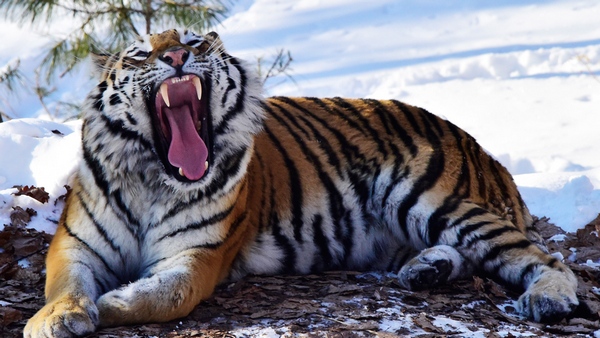
Lifespan
How long do tigers live? Tigers live about the same as their relatives, domestic cats – about 16-20 years on average.
Habitat
Where do tigers live? Tigers live mainly in Asia, from the Siberian taiga to the South Asian jungle of Sumatra. Many tigers live on the territory of such Asian countries as China, Korea, India, Pakistan, Thailand, Vietnam, Cambodia, Burma, Indonesia.
Tigers prefer forest terrain, tropical rainforests, bamboo thickets or the harsh Siberian taiga as habitats. They adapt perfectly to the environment. Tigers like to arrange their lairs in reed thickets near ponds.
Lifestyle
Tiger males mark their territory with special tags (with urine) and protect their territory from the attacks of other tigers.

Under natural conditions, tigers live either singly or in small families (something in the manner of prides among lions). The relations of tigers from one family are always friendly. Sometimes they behave amusingly during communication, touching each other with their faces in contact. But if another tiger accidentally wanders into their territory, then it will not be greeted.
Diet
What do tigers eat? Tigers are notorious predators. An adult tiger at a time can eat 30-40 kg of meat (66-88 pounds). The main source of their food is ungulates and large herbivores: wild boars, tapirs, deer, and roe deer. The tiger is a perfect swimmer and does not mind eating not only meat but also fish. Sometimes even a small elephant may become lunch for a tiger, but tigers are afraid of attacking adult elephants (as well as rhinos).

Tigers hunt at different times – when they hungry, then they go hunting, and this can be either day or night, morning and evening. They always hunt alone, while using two methods: either they are sitting in ambush, patiently waiting for potential prey, or they carefully creep up to it.
Enemies
Since the tiger is literally at the top of the food chain; it has no enemies in natural conditions. (Including other predators: leopards and even packs of wolves are afraid of tigers and prefer to bypass them).

Nevertheless, of course, man became the main enemy of the tiger, moreover, the extermination of tigers by hunters led to the fact that many species of these striped “cats” were on the verge of extinction. Now tigers are listed in the Red Book of the planet, and hunting for them is strictly prohibited.
Species
There are nine species of tigers. Though three of them: the Balinese tiger, the Caspian tiger, and the Javan tiger, unfortunately, have disappeared from the face of the Earth forever. We’ll describe in detail the remaining species that have been preserved.
Amur Tiger
The another name is the Ussuri tiger. The Amur tiger is one of the largest of the tiger family. The Amur tiger has thick fur and a relatively small number of characteristic tiger stripes. According to the estimates of zoologists, the population of Amur tigers totals only 500 individuals that live in the Amur region of Russia. A small number of these tigers also live in North Korea and northeast China. The Amur tiger is entered in the red book.
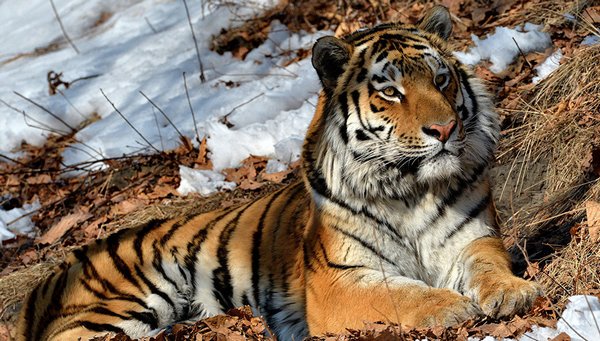
Bengal Tiger
The Bengal tiger is also one of the largest in the tiger family. There are Bengal albino tigers in nature, which are a mutated species. Bengal tigers live in several Asian countries: India, Pakistan, Nepal, Bhutan, Bangladesh.

Indochinese Tiger
The Indochinese tiger has a murky-red color and slightly smaller sizes than their Bengal and Amur relatives. They are up to 2.85 cm in length and weighs 150-195 kg (330-430 pounds). These tigers live in southern China, as well as in Thailand, Vietnam, Cambodia, Laos, Burma.

Malay Tiger
The Malay tiger inhabiting the Malacca Peninsula is notable for being the smallest among tigers. Its length is only 237 cm with a weight of up to 120 kg (260 pounds). Besides this, this tiger is listed in the Red Book and is on the verge of extinction. There are only about 600-800 individuals of the Malay tiger in nature.
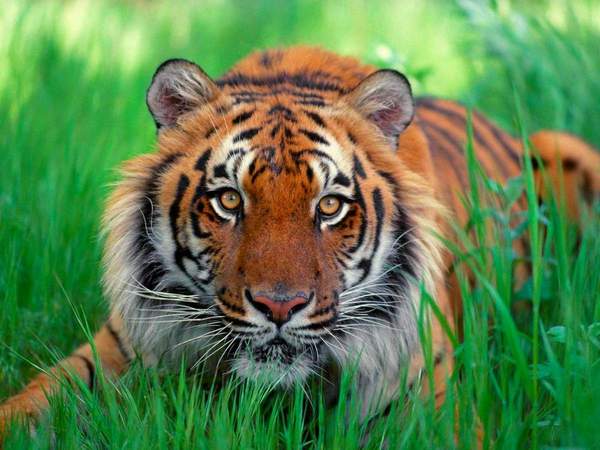
Sumatran Tiger
The Sumatran tiger living on the island of Sumatra and several other islands in Indonesia is also one of the endangered species of the majestic striped predator. The Sumatran tiger also does not big (in comparison with its large relatives, of course), but it is slightly larger than the Malay tiger, its length is 220-225 cm and weighs up to 140 kg (308 pounds).
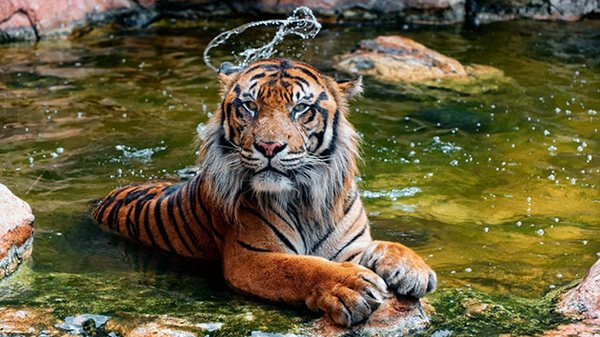
Hybrids
Tiger hybrids are called tigers born from crossing tigers themselves with other representatives of the panther genus. Among them are:
Liger
This is a hybrid of a lion and a female tiger. It has a huge size.
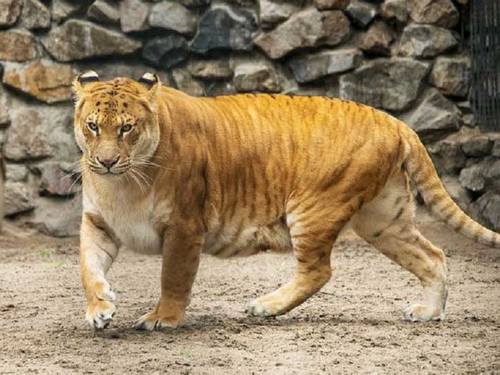
Tigon (Tiglon)
Tigon is just like a liger, but the opposite, its dad is a tiger, and its mother is a lioness. It is smaller in size than its parents and has the features of both: the stripes of the father and the spots of the mother, and males have a mane, though it is several times smaller than that of real lions.

These hybrids of a lion and a tiger are born only in captivity, in zoos, in natural conditions they are not found.
Reproduction
Sexual maturity in tigers occurs in 3-5 years. At the same time, females mature faster.
The mating season in tigers falls in December-January. The male is actively courting the female at this time. Sometimes it happens that two males pretend for one femaleThen a fight occurs between them, and the strongest gets the female.
Pregnancy in a tigress lasts about 100 days; childbirth takes place in a tiger den. 2-4 kids are born at a time, in rare cases, there may be 6. Baby tigers are born blind and only a week later they begin to see. At first, small tigers feed on their mother’s milk.
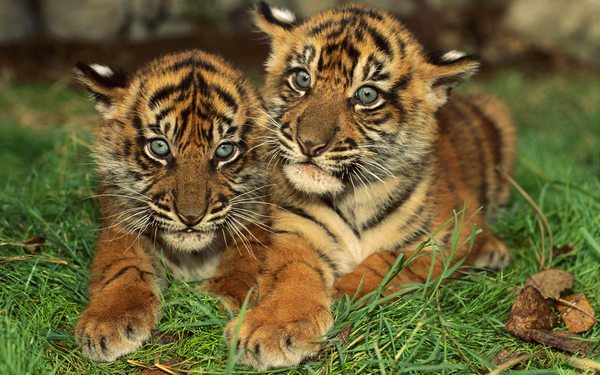
At this time, they grow very quickly. The mother tigress leaves her den for the first time with her children in 2 months after birth. Upon reaching one and a half years, the cubs turn into quite adult and large tigers. Usually, many young tigers live next to their mother before 3-5 years old.
Who is Stronger: a Lion or a Tiger?
For some reason, many are interested in this question. It is not possible to give an exact answer to it since there are very few recorded and documented fights between lions and tigers, which does not allow us to justifiably talk about the superiority of this or that animal. Yet it is possible to compare a lion and a tiger by some external parameters:
- The tiger wins in the weight category. Although it is not much, the tiger still heavier than a lion. (This applies to large species of tigers; small species here will lose to the “king of animals”).
- According to the force of compression of the jaws during a bite, both the tiger and the lion are approximately the same.
- The principle of hunting and killing a prey among lions and tigers is also the same.
- Tigers and lions differ in lifestyle, if lions still prefer to live in prides – small families, then tigers choose a solitary lifestyle, like solitary hunting (lions often hunt collectively). Although tigers sometimes form small families, which could also be called prides, only in such prides they are much less likely to gather than lions.
- According to endurance, it is also impossible to say who is stronger – tigers and lions run very quickly, they can cover significant distances.
In any case, both the tiger and the lion are strong, powerful, and of course very dangerous predators, including dangerous ones for humans.

Interesting Facts
- Since ancient times, the tiger is the hero of numerous tales, myths, and legends. For example, one legend tells us about the saber-toothed tiger, as the progenitor of all predators on Earth.
- Unlike other representatives of the cat family, tigers are not afraid of water and love to swim in it, especially in hot weather.
References and Further Reading
- Goodrich, J.; Lynam, A.; Miquelle, D.; Wibisono, H.; Kawanishi, K.; Pattanavibool, A.; Htun, S.; Tempa, T.; Karki, J.; Jhala, Y. & Karanth, U. (2015). “Panthera tigris”. IUCN Red List of Threatened Species. IUCN. 2015: e.T15955A50659951.
- Linnaeus, C. (1758). “Felis tigris”. Caroli Linn?i Systema natur? per regna tria natur?, secundum classes, ordines, genera, species, cum characteribus, differentiis, synonymis, locis (in Latin). Tomus I (decima, reformata ed.). Holmiae: Laurentius Salvius. p. 41.
- Dinerstein, E.; Loucks, C.; Wikramanayake, E.; Ginsberg, J.; Sanderson, E.; Seidensticker, J.; Forrest, J.; Bryja, G.; Heydlauff, A. (2007). “The Fate of Wild Tigers” (PDF). BioScience. 57 (6): 508–514. doi:10.1641/B570608.
- Liddell, H. G. & Scott, R. (1940). “??????”. A Greek-English Lexicon, revised and augmented. Oxford: Clarendon Press.
- Harper, D. (2001–2011). “Tiger”. Online Etymology Dictionary. Etymonline.com. Retrieved 6 April 2014.

Author: Pavlo Chaika, Editor-in-Chief of the journal Poznavayka
When writing this article, I tried to make it as interesting and useful as possible. I would be grateful for any feedback and constructive criticism in the form of comments to the article. You can also write your wish/question/suggestion to my mail pavelchaika1983@gmail.com or to Facebook.

